#Lab scale blender
Explore tagged Tumblr posts
Text
Double Cone Blender R&D Model

Double Cone Blender R&D lab model is a very efficient and versatile that is widely uses in laboratories. It is also known as small cone blender and that’s because it is pretty compact in size. One of the most popular blenders in the market, this machine is worth your investment.
Lab scale blender has a robust design and it is also known for its long service life. Due to its construction and features, it gives uninterrupted performance. If you are looking for a machine with fully integrated motors, advanced control systems and safety features, this machine deserves to be your pick. Owing to its two dimensional motion that works wonders and provides reproducible mixing results. There is a constant rhythmic pulsing motion that makes this machine a cut above the rest in terms of functionality and efficiency. Small cone blender is a highly efficient machine that requires minimal human intervention. It is ideally suited for small batch sizes.
Enterprises operational in various industries such as cosmetics, pharmaceutical, food and chemical industries choose this machine as it occupies less space and doesn’t demand more than routine maintenance. It also enables loose powder clumps to break easily which helps enhance consistency on all levels throughout the process. You can expect durability and less wear and tear throughout its service life. Besides, any necessary customizations can be made on demand.
0 notes
Text
How to Choose the Right Lab Scale Blender for Your Research?
Selecting the perfect lab scale blender for your research involves considering several key factors to ensure optimal performance and results. Start by evaluating the blender's capacity and compatibility with your sample sizes and materials. Look for features such as variable speed control, programmable settings, and durable construction to match your specific research needs. Assess the blender’s ease of cleaning and maintenance to streamline lab operations. Additionally, consider the reputation of the manufacturer and available customer support for troubleshooting and repairs. By carefully analyzing these aspects, you can choose a that enhances efficiency, accuracy, and reliability in your research projects, leading to more consistent and reproducible outcomes.
Understanding the Importance of Lab Scale Blenders in Research
Lab scale blender are critical tools in various research fields, from pharmaceuticals to materials science. They ensure uniform mixing of small sample sizes, providing consistency and reproducibility in experimental results. Understanding their significance can help you appreciate the need for selecting the right blender for your research needs.
Key Features to Look for in a Lab Scale Blender
When choosing a lab scale blender, focus on features such as capacity, variable speed control, programmable settings, and durability. These characteristics can significantly impact the blender's performance and suitability for your specific research applications. Ensure the blender can handle your typical sample sizes and materials efficiently.
Comparing Different Types of Lab Scale Blenders
Lab scale blenders come in various types, including high-shear mixers, ribbon blenders, and V-blenders. Each type has unique advantages and is suited for different applications. For instance, high-shear mixers are ideal for emulsifying and homogenizing, while ribbon blenders are perfect for dry powders. Compare these types to determine which best fits your research requirements.
Evaluating the Efficiency and Performance of Lab Scale Blenders
Efficiency and performance are crucial when selecting a lab scale blender. Look for blenders that offer consistent and uniform mixing, minimal processing time, and energy efficiency. High-performance blenders can enhance your research productivity by delivering reliable results quickly and with less effort.
Maintenance and Cleaning Considerations for Lab Scale Blenders
Proper maintenance and cleaning are essential for the longevity and optimal performance of lab scale blenders. Choose a blender that is easy to disassemble and clean, with accessible parts and straightforward maintenance procedures. Regular maintenance ensures the blender remains in top condition and reduces the risk of contamination.
The Role of Lab Scale Blenders in Quality Control
In quality control, lab scale blenders play a vital role in ensuring product consistency and compliance with industry standards. They are used to prepare uniform samples for testing, which helps in accurate quality assessment. Selecting the right blender can significantly impact the reliability of your quality control processes.
Advancements in Lab Scale Blender Technology
Recent advancements in lab scale blender technology have introduced features like digital controls, enhanced safety mechanisms, and improved energy efficiency. Staying updated with these innovations can help you choose a modern blender that offers better performance, ease of use, and reliability.
Conclusion
Choosing the right lab scale blender for your research is a crucial decision that impacts the efficiency, accuracy, and reliability of your work. By understanding the importance of, evaluating key features, comparing different types, and considering maintenance and technological advancements, you can make an informed choice. A well-chosen not only enhances your research capabilities but also ensures consistent and reproducible results, paving the way for successful experiments and discoveries.
0 notes
Text
The Benefits of Using a Lab Scale Blender in Research and Development
Using a lab scale blender in research and development offers numerous benefits, significantly enhancing the efficiency and precision of experimental processes. These blenders ensure uniform mixing of small batches of materials, which is crucial for accurate and repeatable results in experiments. Their precise control over blending parameters allows researchers to optimize formulations and processes, leading to better product development and innovation. Additionally, save time and reduce labor costs by automating mixing tasks, freeing researchers to focus on analysis and interpretation. They are also designed for easy cleaning and maintenance, ensuring contamination-free operations. Overall, are indispensable tools that contribute to more efficient, reliable, and innovative research and development outcomes.
Introduction to Lab Scale Blenders
Lab scale blender are essential tools in research and development, designed to mix small batches of materials with precision and uniformity. These devices are crucial for various industries, including pharmaceuticals, chemicals, and food production, where consistent blending is vital for accurate experimentation and product development.
Key Features of Lab Scale Blenders
Lab scale blenders come equipped with various features that enhance their functionality. These include adjustable speed controls, programmable settings, and a range of container sizes. Their compact design makes them suitable for small lab spaces, while their advanced technology ensures precise and efficient blending, catering to the specific needs of laboratory environments.
Applications of Lab Scale Blenders in Different Industries
Lab scale blenders are widely used across multiple industries. In pharmaceuticals, they are essential for mixing active ingredients and excipients. In the chemical industry, they help in developing new compounds and formulations. Food scientists use them to test new recipes and ingredients. These blenders facilitate innovation and quality control, making them indispensable in R&D settings.
Advantages of Using Lab Scale Blenders in Research and Development
The primary benefit of lab scale blenders in R&D is their ability to produce consistent and repeatable results. They enhance the efficiency of the mixing process, saving time and resources. Their precision ensures that each batch is uniformly blended, which is crucial for the accuracy of experimental data. Additionally, they reduce the risk of contamination and human error, leading to more reliable outcomes.
Selecting the Right Lab Scale Blender for Your Needs
Choosing the appropriate lab scale blender depends on several factors, including the nature of the materials being blended, the required batch size, and specific application needs. It's important to consider features such as blending speed, capacity, ease of cleaning, and compatibility with different types of materials. Consulting with manufacturers and reviewing technical specifications can help in making an informed decision.
Maintenance and Care for Lab Scale Blenders
Proper maintenance and care are crucial for the longevity and performance of lab scale blenders. Regular cleaning to prevent cross-contamination, periodic inspection of parts, and adherence to the manufacturer’s maintenance guidelines ensure that the blender operates efficiently. Proper care not only extends the life of the equipment but also maintains the integrity of the research results.
Future Trends in Lab Scale Blender Technology
The future of lab scale blenders looks promising with advancements in technology. Innovations such as automated cleaning systems, enhanced precision controls, and integration with digital data systems are on the horizon. These developments will further streamline the blending process, making lab scale blenders even more efficient and versatile. As technology progresses, lab scale blenders will continue to evolve, supporting more sophisticated and complex research and development projects.
Conclusion
The benefits of using a lab scale blender in research and development are manifold and essential for advancing scientific innovation. These blenders ensure precise and consistent mixing of small batches, crucial for producing reliable experimental data and refining product formulations. By facilitating efficient blending processes, they save valuable time and resources, allowing researchers to focus on analysis and interpretation. The ability to customize blending parameters and control variables enhances experimental reproducibility, promoting accuracy in results. Additionally, contribute to quality assurance by minimizing variability and ensuring uniformity across samples. Their versatility across diverse industries underscores their importance in driving R&D forward, supporting breakthroughs in pharmaceuticals, chemicals, food science, and beyond. As technology continues to evolve, tools in optimizing research efficiency and achieving innovative advancements in various scientific disciplines.
0 notes
Text
The Importance of Speed Control in Lab Scale Blenders
Speed control in lab scale blenders is crucial for achieving precise and consistent results in laboratory processes. It allows researchers to tailor blending speeds to the specific properties of materials, ensuring optimal mixing without compromising the integrity of sensitive components. Adjustable speed settings help prevent issues like over-blending or inadequate homogenization, which can impact the quality of experimental outcomes. Additionally, speed control minimizes the risk of overheating, preserving the chemical and physical properties of substances. This feature is particularly essential in applications requiring delicate handling, such as pharmaceutical formulations, chemical research, and food science. By providing versatility and precision, speed control in lab scale blenders enhances efficiency and accuracy, making it a vital component in modern laboratory workflows.
Introduction to Lab Scale Blenders: What Are They and Why Are They Essential?
Lab scale blenders are compact mixing solutions designed for precise, small-scale blending tasks in industries like pharmaceuticals, food processing, and cosmetics. They ensure accurate mixing of powders, granules, or liquids, making them indispensable for research, product development, and quality testing.
Key Features to Look for in a Lab Scale Blender
When choosing a lab scale blender, features like variable speed control, interchangeable containers, and easy cleaning options are essential. The size, blending mechanism, and material compatibility also play a crucial role in ensuring optimal performance for diverse applications.
Types of Lab Scale Blenders and Their Applications
Lab scale blenders come in various designs, including V-blenders, ribbon blenders, and paddle blenders. Each type serves specific needs, such as uniform powder mixing, delicate material handling, or high-shear blending for viscous substances.
Benefits of Using Lab Scale Blenders in Research and Development
Lab scale blenders enable precise experimentation, ensuring consistent results while minimizing material waste. They facilitate small-batch production, helping businesses test new formulations, streamline processes, and achieve better scalability for larger production.
How to Maintain Your Lab Scale Blender for Long-Lasting Performance?
Proper maintenance of lab scale blenders is critical for durability. Regular cleaning, timely lubrication, and monitoring for wear and tear ensure efficient functioning and reduce the risk of contamination or operational delays.
Common Mistakes to Avoid When Using a Lab Scale Blender
Incorrect loading, choosing incompatible materials, or neglecting speed settings can impact blending results. Understanding your blender’s specifications and following operational guidelines helps prevent errors and ensures consistent performance.
Leading Manufacturers of Lab Scale Blenders You Should Know
Top manufacturers like IKA, Waring, and Ross offer innovative lab scale blenders with advanced features. Investing in high-quality equipment from reliable brands ensures durability, precision, and seamless integration into laboratory workflows.
Conclusion
Lab scale blenders are vital tools for precision, efficiency, and innovation across industries. Their ability to handle complex blending tasks on a small scale empowers researchers and manufacturers to develop high-quality products with confidence. By understanding their features, applications, and maintenance needs, businesses can make informed decisions and maximize the benefits of these versatile devices. Investing in a reliable lab scale blender is an essential step toward improving productivity and achieving better outcomes in research and production.
0 notes
Text
Process - Sunakawa Cake 🎂
A little breakdown of how I made my 3D recreation of the "thank you sunakawa" cake from Ore Monogatari ~

1. Collecting reference
Aside from referencing stills from the anime, I came across the official cake sketch from Madhouse's website! It was really helpful in identifying all the toppings on the cake and other details.
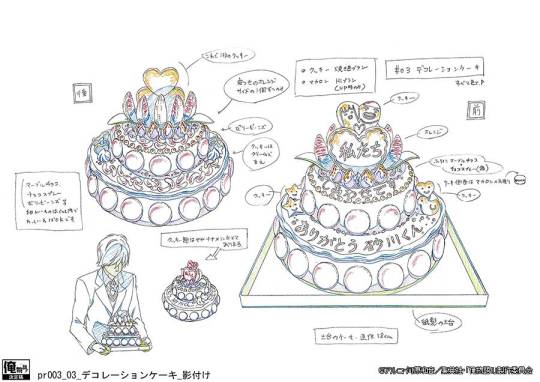

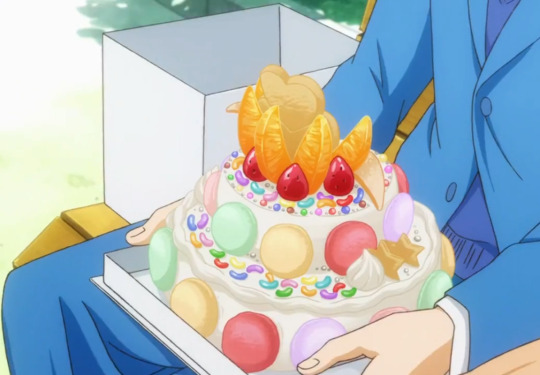
Next was collecting real-life references of all the ingredients I needed to make and taking notes of the shapes, textures and variety.
2. Modelling & Texturing
I go back and forth between modelling and texturing, and jump all over the place so I'll break things down based on the toppings/elements:
A. Macaron
I referenced Canosie Lab's macaron tutorial here, tweaking the process a little bit; using one mesh instead of two and using particles to distribute the boolean meshes. I ended up with LOTS of vertices, so I made a lower poly version of the macaron and used those to avoid bogging down the computer. As for the texture, I used Blender's procedural nodes, utilizing mostly the noise texture node.

Above: The first row are the lower poly versions of the macaron and the second row are the original meshes with around 200,000 vertices each o_o

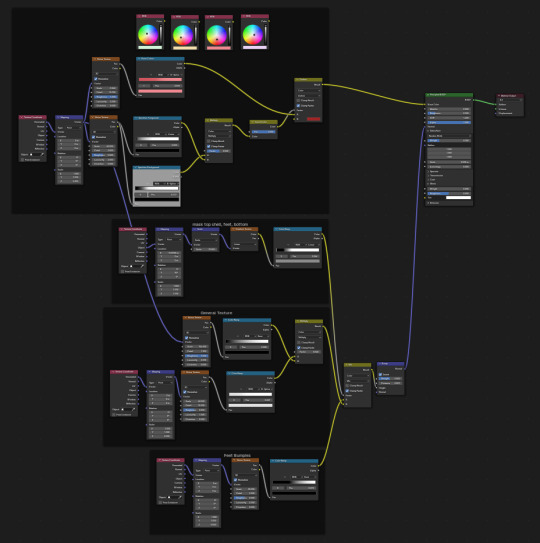
B. Cookies
There's not much to it here; I just modeled the cookies and used procedural textures I've made for a previous project (I'll post that project soon!!!)
The icing is made using bezier curves with some bevel depth. I used the draw tool to draw on the cookies. I did the same for the writings on the cake.
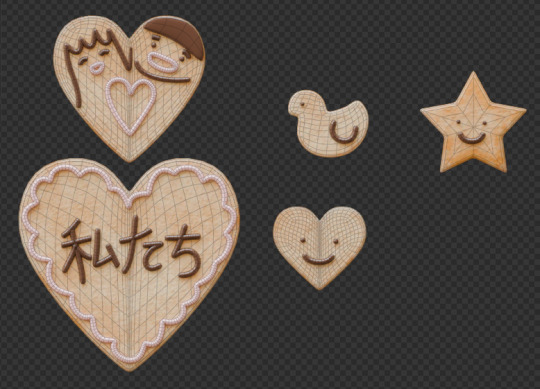
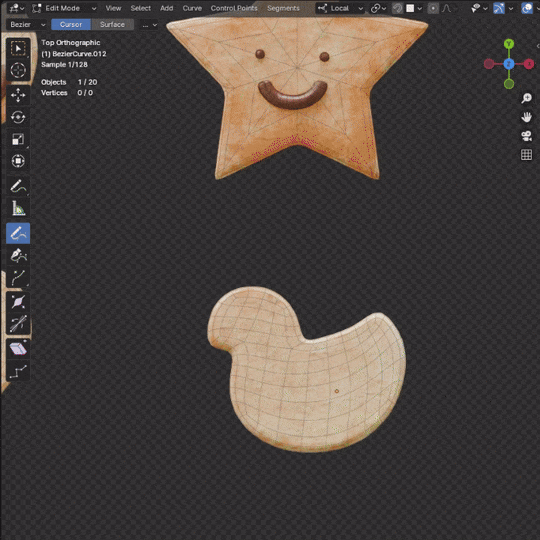
C. Strawberries
I've previously made strawberries for another project so I just used those but baked them to a lower poly mesh first. I used Canosie Labs' strawberry tutorial as reference :) I initially used a scaled down version of the regular-sized strawbs, but decided to make a proper mini strawberry 🍓

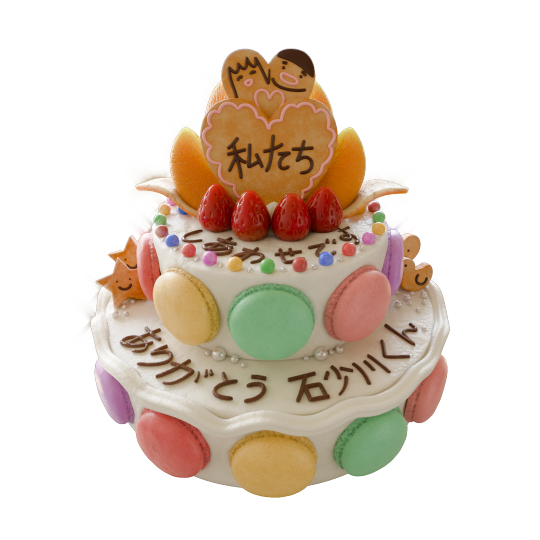
Left: with scaled down regular strawberries, Right: proper mini strawberries.

I made them super shiny with lots of subsurface scattering to make them look juicy and gummy-like -- not the most realistic but I think they look cuter like this :>
D. Orange slices
The orange slices were the most challenging to make! Did a lot of trial and error to get that pulpy texture oranges have but I managed using a combination of voronoi nodes :") If you look at the pictures below, you can see how the orange looked in the beginning vs. at the end after I refined it some more.
They look fine from a distance but a little janky up close; maybe I'll do a breakdown one day once I figure out a proper node setup.

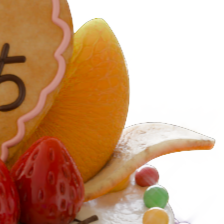
Above: before & after
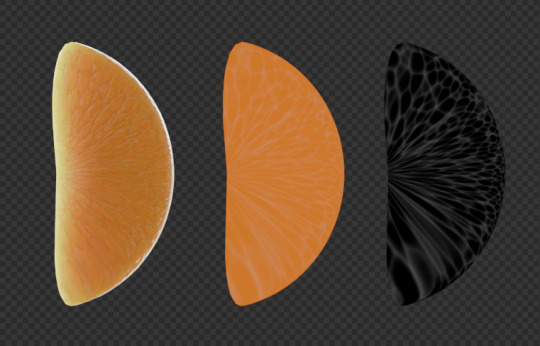
Left to right: rendered, colour only, B/W
E. Orange peel
A simple plane with a solidify and curve modifier. What's most important here is the texture! I used two different shaders (one for the pith another for the peel) combined using a mask.
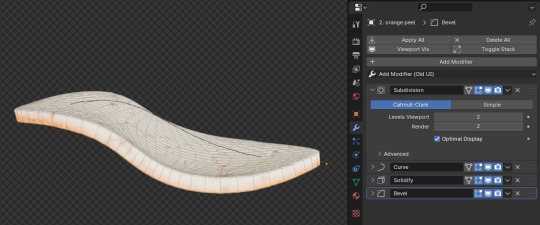
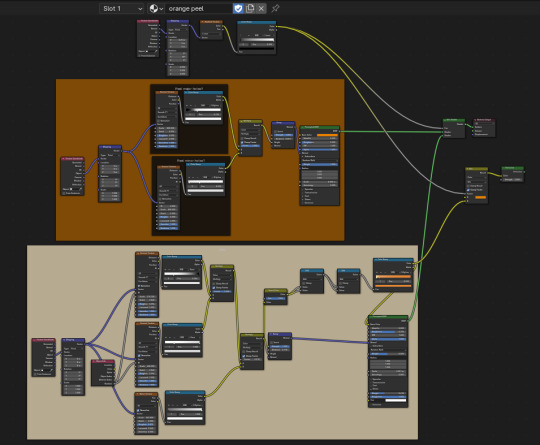
F. Jelly beans & choco marbles
A tweaked subdivided square for the jelly beans and subdivided icosphere for the choco marbles. The two use pretty much the same shaders but the jelly beans have more subsurface scattering.
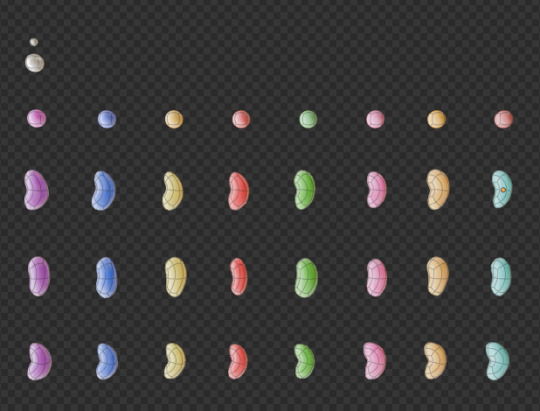
H. Cake
After placing all the toppings, I sculpted the cake (using the multires modifier) a little bit to model the cream that's displaced.


#ore monogatari#sunakawa makoto#process#3d modeling#artists on tumblr#blender#blender 3d#3d model#cake#b3d#3d art#3d render#3d#digital art
30 notes
·
View notes
Text
Magma Grunt Fact 11:
Admin Tabitha has this really cool Holographic 3D rendering Machine within his Lab.
I'll admit that I'm not smart enough to fully understand what it is used for or even how to operate it but from what I can say is that it functions on the same program as Blender.
It is this huge Holographic Projector where him and his scientists can craft Models IRL with this touch screen interface. And since this hologram runs on the same program as blender it pretty much has all the features except say for a few less "artistic features" in replace of more buttons to input formulas.
It is like a calculator, modeling tool, and tablet all in one.
(From what I've been told this was how the submarine was designed without needing to print out a scale model since the hologram is projected to show accurate scaling)
#magma grunt zesty#magma grunt#team magma#rotomblr#just zesty thoughts#pokemon team magma#pokemon#oras#magma admin tabitha#admin tabitha
5 notes
·
View notes
Text
A Silly Idea
Spawned from reading too many of Star_going_supernova's Godzilla stories.
So I've got this kinda stupid idea in my head.
It started with me remembering the old Godzilla cartoon from 1998( henceforth being referred to as the only thing of worth coming from the 1998 movie) and I thought that it would be cool if they did something like that nowadays with the Legendary versions.
It was at that point my brain threw the Legendary Godzilla in a blender with some 90's era ‘we'll-make-a-cartoon-outta-anything’ juice mixed with a bit of Star_Going_Supernova influence spice, hit puree, and spilled this slurrie everywhere.
Which I will now regurgitate to any one willing to read this.
So Cody's Idea Corner now presents:
Envoys of the King:
A Godzilla Pilot.
So it starts with a view of an aircraft carrier. We see the Monarch symbol emblazoned upon it. Monarch employees bustle around on it, giving an 18 year old sitting on a crate a large berth, or rather the large bear-sized lump of familiar scales behind him a large berth.
The teen looks tired, like ‘put through the ringer and now I'm just done tired’. He has short black hair and brown eyes. He's of Japanese descent and wearing a long brown coat.
In walks Maddie Russell. She walks straight up to him.
“Hi,” she says.
“Sup,” he responded.
“I'm Maddie.”
“Martin.”
“So Martin,” she starts. “Why's everybody avoiding you?”
“Think they're more avoiding the big grumpy lizard than me.”
He points back to the lump of scales. Maddie stares at it.
As if sensing her stare it raises its head, its face is familiar to Maddie.
“Who's that?” She asks. “Kindda looks like Godzilla, if he were smaller.”
Martin sighs.
“That's because it is Godzilla.”
Maddie double takes.
“...what?”
“It’s… it's a long story.”
Behind him Godzilla huffs. Martin rolls his eyes.
“Which the lizard wants me to tell apparently.”
“Wait, you can understand him?”
“That's…”
“Also a long story?”
“Eh, more of the same story.”
“Okay this I gotta hear.”
“Pull up a crate,” Martin says, waving over to some other boxes. “Don't got much else going on right now.”
Maddie pulls over a box and sits down. Expectantly waiting for Martin to begin.
He sighs.
“Okay, where to start…”
----------------------------
So about a year ago my grandpa passed. In his will, he left me four things.
The first was a bunch of money. Said to use it to travel the world. Find myself.
The second was this bag that had eight, uh, guess I'll call em crests.
Third was this crystal sword.
Fourth was a journal. The journal was full of writing in different languages. What I could read was just confusing and made no sense. At the back of the journal was a message from grandpa; ‘you'll know what to do when it's time.’
----------------------------
Maddie: That's it?
Yep.
Maddie: Well, that's… vague…
You're telling me. Anyway, with nothing else to go on, I did the other thing he told me to do, I went traveling. Till I ended up here.
I'd heard Monarch was doing some sort of dig outside of town. Cordoned it off and everything. Normally, it wouldn't have mattered to me but, I don't know, I felt… drawn to the place. Like I'd just be doing my thing and suddenly I'm staring off in the direction of the dig.
Maddie: So what did you do?
What I imagine any self-respecting teenager with no adult supervision and an inexplicable draw to an off limits sight would do.
Maddie:... you broke in?
I broke in, yeah. And… I got caught. That. Is when the crazy stuff happened.
----------------------------
Martin sits in what appears to be an interrogation room. He sits in the chair, slouched back and staring at the ceiling.
‘You're an idiot, Martin!’ He scolds himself.
Before he can berate himself further, the door opens, letting in a woman with blonde pixie cut hair. She wore a lab coat and held a tablet in her hand.
“Martin Yami?” She asked as she sat down in front of him. “Or do you prefer Yami Martin.”
“I was raised in the states,” he grumbled. “Martin's fine.”
“Very well.” She smiled softly. “My name is Leana Marpole. I work as a Doctor of archeology for Monarch.”
Martin raised a brow.
“Archeology? Thought Monarch was full of Kaiju researchers?”
Before she could answer, he shook his head.
“Nevermind, doesn't matter. Look Miss Marpole-”
“Call me Leana.”
“Fine. Miss Leana, if you guys are gonna pull a ‘Men In Black’ on me, could we just get it over with?” He sighed. “It was a mistake to go in there. I'm not even sure why I did it.”
She chuckled.
“I don't know what rumors you've heard about Monarch's technology, but we're not advanced enough to rewrite memories.” She smirked. “Or perhaps you were referring to the methods of the original comics?”
Martin blinked.
“I… was actually… how do you know that?”
She laughed.
“A fond part of my childhood,” she said brightly. “Regardless, I can assure you that we plan on doing no such thing.”
“Hmm.”
His eyes narrowed in thought.
“Wait, those comics are like thirty years old. You read them as a kid? So you're like-”
“Although, I could convince the General to adopt some of those methods, if you would like to continue down that train of thought?” she interjected with a clearly false cheer.
“Uhhhhh… noted…” He coughed. “Uhm, a-anyway, if you're not planning to do… that… then why am I here instead of with the police for standard B'n'E?”
“To answer one of your earlier questions,” she began as she tapped away on the tablet. “Titans have existed long before humanity. There are even records of temples of worship to some of them, and I will be the first to tell you, zoologists, do not make good archeologists.”
“Okay, fair,” he said with a nod. “So Monarch needs archeologists to study these supposed kaiju temples. Still doesn't explain why I'm here.”
“Kaiju…” she mumbled. “Most of the world refers to them as titans.
“Its… just what my grandpa always called them,” he said softly. “It stuck.”
“Ah, yes, your paternal grandfather. Your file mentioned he passed a year ago?” She asked, her eyes glinting with sympathy. “It must have been hard, losing your only family.”
“Uh, y-yeah,” he glanced away.
Even a year later, it still hurt.
‘For it to still hurt, means that there is still love there.’
His grandpa's words echoed through his head.
He took a deep breath.
“Can we- can we get back to the part about why I'm here?”
Leana nodded.
“You are still here, Martin, because I would like to ask you about some items you had in your possession when you were detained.”
Martin sighed and leaned back.
“Well, sorry to tell ya, but it's a dead end. They were just in a box my grandpa left me in his will,” he said. “You all probably know more about them than I do.”
“If you would just humor me for a minute, Martin.”
“Fine, but all I got is puns,” he mumbled under his breath.
She snorted before setting the tablet in front of him.
“Do you recognize this symbol?” She asked.
Martin studied the image. It looked like it had been carved into a stone wall. It also did look familiar.
“Actually… yeah… it looks like one of the symbols in the book.”
“Yes,” Leana agreed. “It's pretty much an exact match. You said your grandfather gave you the book?”
“Yeah but I know he didn't write it.”
“No, the brush strokes and marking are indicative of multiple writers,” she explained. “We dated the book as best we could and while it is only a few hundred years old-”
“A ‘few hundred’ she says.”
“Some of the language used in it is much older.”
“Yeah, but it's probably all written in code,” Martin said with a shrug. “There's kanji in there. I can read kanji but it just seems like gibberish.”
“Yes, we noticed that,” she said, taking back the tablet. “Moving on, what do you know about the sword?”
Martin leaned back in his chair and stared at the ceiling.
“Well there's not really anything special about the tsuka or saya,” he supplied. “But the blade and tsuba are made of some weird materials.”
“Referring to them in the traditional way,” she hummed. “Are you a swordsman, Martin?”
He shook his head.
“Just did some kendo when I was younger,” he said. “They nail those terms into your head before they even let you look at a boken.”
“And do you still practice?”
“I still know the basics, practice ‘em once in a while.” He sighed. “Grandpa said it may come in handy one day.”
----------------------------
“So your grandpa made you take kendo as a kid,” Maddie interrupted. “Encourages you to at least practice the basics, dies, and then leaves you a sword and a note saying ‘travel the world’ and ‘You'll know what to do when its time.’?”
Martin nodded.
“Yep. Really suspicious in hindsight.”
“Okay, cool,” she said. “Not just me.”
----------------------------
“Anyway,” Martin continued. “The whole blade is some kinda crystal and the tsuba looks like its the same kinda stuff as the crest.”
Leana nodded.
“Correct,” she confirmed. She showed him the tablet once again. “The materials used in the blade, the ‘tsuba’-”
“You can just call it the guard if you want,” Martin said. “Wouldn't be insulting me or anything. Not like it's a common term.”
Leana smiled and continued.
“And the crests are all incredibly dense, but thanks to another artifact Monarch has access to we have been able to identify the substance used to make the blade.”
“And what's that?”
Leana grinned and showed him the tablet. On it was a picture of the katana next to another picture that looked like a crude axe.
“The axe you see has the same makeup as your sword and the axe is made from the dorsal plates of ‘Titanus Gojira’,” she said, steppling her hands. “Or, his more common name-”
“Godzilla!?” Martin cried. “The thing is made out of one of his back spines!?”
“It would appear so,” she stated. “And with the crest's unique feature of absorbing radiation-”
“Should I be worried about that?”
She shook her head.
“While they do absorb ambient radiation, their output of radiation is no worse than that of a banana.”
“So avoid eating 20,000 of them, got it,” Martin joked.
Leana chuckled.
“Yes, but as I was saying, based on that fact, its likely they are made from Godzilla tissue as well, likely his scales, if I had to guess.”
Martin rubbed his forehead.
“Why the heck did you have these, Grandpa?” He asked softly.
“And that's the million dollar question, Martin,” Leana said with a sigh. “The cultural significance of these items alone is incalculable, not to mention what they would be worth to collectors.” She looked him in the eyes. “It's clear he knew to some extent the meaning behind these objects. So why did he leave them with his grandson, and why did said grandson try to sneak onto a Monarch research site?”
Before Martin could even think of how to respond, an alarm went off.
----------------------------
After that, some stuff happens, I got my things back, small monsters show up, chaos and destruction, Godzilla stands in the bay, and me and Ms. Leana end up at the top of an altar Monarch dug up.
“... I feel like you're skipping a bunch of stuff.”
It was mostly just a lot of running and screaming every curse word I know.
“Ah, yeah, been there. Welcome to the club.”
Are there t-shirts?
“I'm getting some made. What size do you want?”
Put me down for an extra large. Anyway, so me and Ms. Leana are on top of this altar, right?
----------------------------
As the two crested the stairs, Martin could admit that the altar had a pretty good view of the bay. There wasn't a lot at the top. Just a single stone wall to his right with writing on it and a large stone ring in front of him.
“Don't cross that line, Martin,” Leana warned, pointing to a line on the floor. “Everything past that line, I'm told, is radioactive. To a point, it would be lethal to stand in it too long.” She turned to the wall. “I haven't been up here yet.” She gasped. “Martin, look, these symbols match certain pages of your book.”
She sighed.
“Oh, if only we could read them.”
Martin stared at the strange symbols. His hand went to one of the crests now hanging from his neck.
A brow raised.
“Wait,” he mumbled. “I can… I can read this!”
“What?”
The letters glowed, rearranging themselves into a form he could understand.
“Martin,” Leana said with another gasp. “The crest is glowing! It must be somehow tied to the ruins!”
“Its letting me understand the words.”
“Well, what do they say?” she asked giddily.
“To you who now faces the trial of the envoy,” he read slowly. “Show your strength and courage to the King. Let his starfire cleanse you of indecision…”
“Fascinating,” she breathed. “If I had to guess, it must relate to some kind of ritual, most likely towards Godzilla, given the interaction with the crest and the use of the word king.”
“A ritual involving the King of monsters,” Martin mumbled.
He glanced back towards the arch.
“The use of starfire though,” she pondered. “Perhaps, a primitive understanding of his atomic breath?”
“Maybe,” he agreed, walking back over to the line. “Everything past that line is radioactive.”
“Perhaps these supposed ‘envoys’ were meant to stand in that area as a test of courage.”
Somehow, Martin didn't feel that was right. An arch with a direct line to the bay, plus a radioactive area, plus the phrase ‘let his starfire cleanse you of indecision.”, yeah, Martin was starting to get a clearer picture of this ritual.
It seemed Leana was as well, as she suddenly went tense.
“We should go,” she said firmly, almost nervously.
Suddenly there was a loud noise, a sound from the bay. Martin glanced out. Godzilla was looking at the top of the altar.
‘No,’ Martin's brain supplied. ‘He's looking at you.’
Somehow, it felt like the great lizard was locking eyes with him. Martin felt rooted to the spot.
Godzilla let out a roar. His dorsal fins began to glow.
Martin gripped his head.
‘Best grit your teeth, welp!’
A demand. Somehow entering directly into his mind, from the king himself.
“Martin!” Leana called over the roar.
She stood behind him.
“Run, Ms. Leana!”
“Its too late!” she cried. “We'll never make it before he fires!”
As if to prove her point, Godzilla fired directly at the arch.
A single thought entered Martin's head as he threw the sword's sheath aside and raised said sword high above his head.
‘I am about to do something very very stupid.’
The beam approached and Martin swung.
----------------------------
“Hold up! Wait!” Maddie interrupted. You are telling me that Big G fired his ATOMIC BREATH, a beam as wide as a skyscraper at you, and your reaction is to try to CUT THROUGH the beam like a shonen anime protagonist?!”
Look, no matter how you slice it, I pretty much thought I was gonna die anyway. If I'm gonna go out, I might as well try something cool.
“...fair enough. continue.”
----------------------------
It burned. It burned his arms with the strain. It burned from the heat. It burned his very soul.
Or at least it felt like it.
The strange sword split the beam, diverting it around them.
‘WHY IS THIS WORKING!?’ he mentally screamed.
He held on through the onslaught. He doubted he could have let go even if he wanted to. It felt like his hands were melted to the hilt.
In a seconds that felt like years, the beam finally stopped.
Martin dropped to his knees, panting hard. The now glowing blade was still in his hands. Up his arms were glowing marks, similar to litchenburg figures. The glow from the marks soon receded down towards his hands, like the blade was drawing it out of his skin.
Leana dropped beside him.
“Martin!” she cried. “Are you okay?”
“WHY DID I DO THAT!?” he screamed in a rather manic manner. “AND WHY DID THAT WORK!?”
Another sound brought his eyes to the kaiju out in the bay.
Did… did Godzilla just nod at him.
Apparently Leanna saw it too as she let out an audible gulp.
“C-congrats, Martin,” she stuttered
“I think you passed the test. You're an envoy to the King.”
“What does that even mean?” he growled.
Leanna helped him stand up. His hands were no longer numb, so he removed one hand from the sword and flexed his fingers.
Leanna grabbed said hand and looked it over.
“The burning looks minimal,” she mumbled as she looked him over. “Rather fascinating given the circumstances.”
Leanna pulled a first aid kit out of her bag and tended to his burned palms.
“We're lucky to be alive,” Martin grumbled. “Overgrown lizard nearly fried us.”
“Careful, Martin,” she teased. “That overgrown lizard is your new king.”
“Well, I didn't vote for him.”
Leanna chuckled. She finished wrapping his hands and put an arm around his shoulder.
“All done,” she stated. “Now let's go before the King decides to test you again.”
“Yeah,” he sighed. “Really don't want to do that twice today… or ever.”
----------------------------
“After that?” Maddie asked.
Martin looked up at the sky.
“Uh, well,” he began. “After that, we went back into the tunnels, met the monster again, this guy shows up out of nowhere, now somehow small, helps hold down the strange spider creature and I stab it.” He taps his chin. “Think that covers it.”
Maddie stares.
“...oh, is that all,” she says sarcastically.
“Its… kinda all one adrenaline infused blur for me.” He shrugged. “Sorry to disappoint.”
She shakes her head.
“It's fine,” she says with a chuckle. “An envoy to Godzilla.” There's a small amount of awe in her voice. “That sounds so cool.”
“It's really not,” Martin grumbled. “He's cranky, grumpy, won't stop calling me ‘welp’-”
Godzilla growled from his spot.
“What? Why?”
“What did he say?” Maddie asked.
Martin turned to her and looked at her critically.
“He… wants me to give you one of the crests…” ----------------------------
Ctk: From this point, Maddie would get a crest and not need to do a trial because, in Godzilla's ‘words’, ‘the pup already proved her strength when she roared at the Usurper when she was nothing but a hatchling.’.
From there it would be revealed that Godzilla is smaller due to a pact he made with humans long ago, but he can return to normal size briefly if his ‘priestess’ (the titan language doesn't have a direct translation for Maddie's role, so priestess it is.) recites a phrase from Martin's book. (Meaning that big g has a transformation sequence that will be used every episode, usually after Martin spouts a pun related to the monster of the day.)
Godzilla goes on to explain that something is coming, he can feel it, and he needs to gather new envoys, because, as loath as he is to admit it, it will take more than himself to stop it.
Cue action-packed adventures of Martin, Maddie, Leanna, and Godzilla traveling the world, fighting monsters big and small and finding the supposed envoys.
… that's what I got.
This has been a stupid idea from Cody.
So long.
#legendary godzilla#Madison Russel#Star_going_supernova Inspired#90's/ early 2000 cartoon inspired#au idea#fanfic ideas
12 notes
·
View notes
Text
My biggest problem rn with those web tools that "help" you with poses for drawing is not only that they only have these very basic and stiff reference models that you can only use in the free version, but the fact that their tools are about 30 years behind on literally any other 3D tool that lets you pose characters. IK rigs? Never heard of her, anyways pay us to get access to the actually good and versatile character ref models, plus hundreds of pre-made poses you will have to use because our posing tools are fundamentally shit and outdated so you will pay for the premium. Do yourself a favour as an artist and download Blender, get MB-Lab's addon, and have fun cuz you now have access to 15 base humanoid models that not only you can pose around with full IK rigs (which essentially make it so you can drag hands and the arms will follow, feet and the legs will follow, drop the hips and the legs will bend), but also you have full freedom to modify, scale, and deform these models as you see fit. There is a whole world of tutorials for Blender now and guess what, you can even sketch and reposition those 2d sketches in 3d space inside of the Blender viewport. If you need anything from props, rough space reference in full 3d or need multiple characters interacting, you can simply download or even model those and add them to your scene! There are so many free models out there a google away on Sketchfab and other places. This is a quick post about all the stuff you can do with Blender as a 2d artist because I saw my partner struggling with those """free""" pose ref sites and got really angry that they're not even good tools, but still prey on artists who don't know any better to pay for slightly less mediocre tools. Feel free to reblog with more info!
5 notes
·
View notes
Text
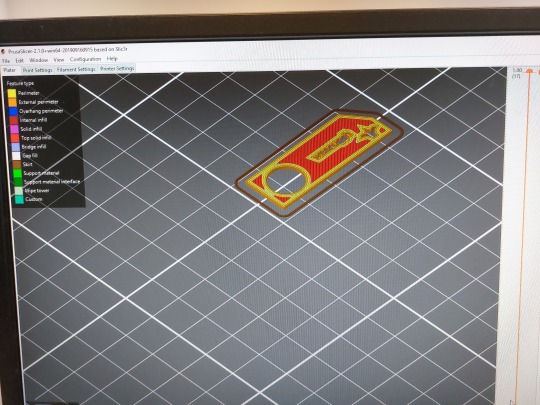

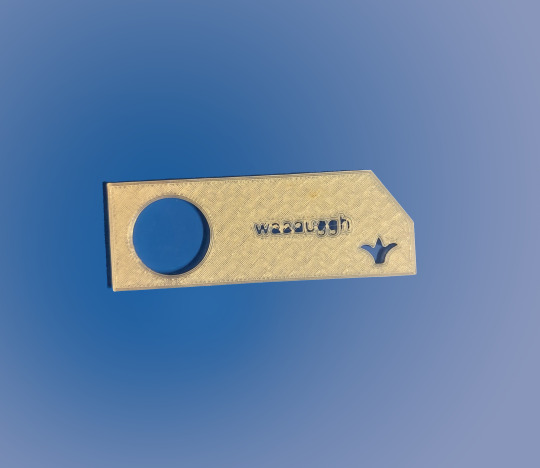
On Monday I did the 3D Printing workshop. As Blender wasn't available in the computer lab, I had to use Rhino 6, which was very difficult to use. I managed to cut letters and a design out of the keyring, but the action was difficult to repeat, as such it has little relevance to the project. I will be sticking to Blender, as I have experience with it and it tends to work more consistently. I was able to set up the 3D print file in PrusaSlicer and adjust the infill level, which can be seen as a lattice pattern in the keyring.
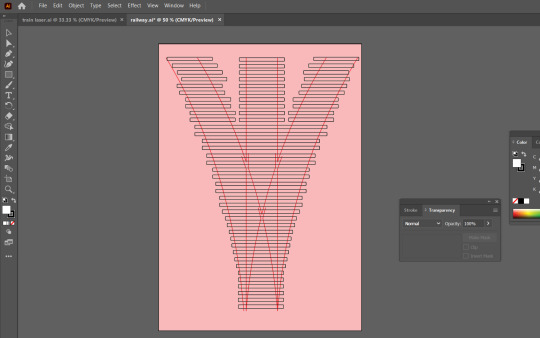
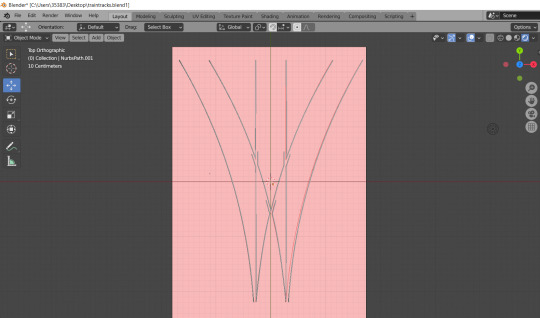
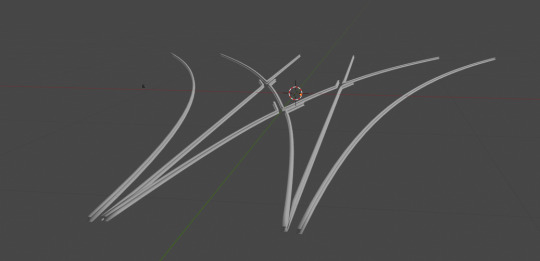
I created a railroad switch in Blender, with the help of Illustrator for the template and a guide for laser cutting the railroad sleepers. In Blender I used paths and bevel geometry to achieve a uniform look across the rails. This was my second attempt at the exercise as I did not pay attention to scaling, rendering each rail a totally random size. I hope to print, cut and assemble these into a diorama.
4 notes
·
View notes
Text
AMD Ryzen Threadripper PRO 5995WX Price And Specs
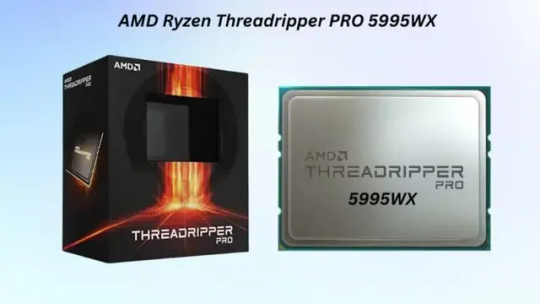
This article details AMD Ryzen Threadripper PRO 5995WX price, pros, cons, etc.
Ryzen Threadripper PRO 5995WX
The workstation-class AMD Ryzen Threadripper PRO 5995WX provides security, memory bandwidth, and multi-core performance for high-end professionals. Best workstation CPU for engineers, data scientists, and artists is AMD Zen 3 5995WX.
Features
128 64 cores, 128 threads: The 5995WX, one of the most powerful consumer-accessible CPUs, is suited for large-scale compilation, video creation, simulation, and 3D rendering.
Base and Boost Clocks: It accelerates from 2.7 GHz to 4.5 GHz for rapid single-threaded and multi-threaded performance.
It was intended for the WRX80 motherboard platform and supports ECC memory, advanced I/O, several PCIe Gen 4 lanes, and a broad range of memory configurations.
Security & Manageability: AMD PRO Technologies, including AMD Secure Processor for safe boot and data protection and AMD Memory Guard for real-time system memory encryption, provide enterprise-grade security.
Architecture
Zen 3 Architecture: AMD's 7nm Zen 3 core design delivers the Threadripper PRO 5995WX shorter latency, higher IPC, and a better cache layout than Zen 2.
This modular chiplet-based architecture scales core counts while maintaining power efficiency by grouping several CCDs (Core Complex Dies) beneath a single IHS (integrated heat spreader).
A unified 8-channel DDR4 memory controller speeds Apple memory access times in the Zen 3, which fixes Threadrippers' NUMA issues.
Performance
5995WX multi-core performance is industry standard in Blender, Adobe Premiere Pro, DaVinci Resolve, and AutoCAD. It outperforms powerful multi-threaded benchmarks and matches top dual-CPU workstations.
Single-core Performance: Zen 3's high boost speeds and IPC enhancements put it closer to standard CPUs in single-threaded applications.
Professional Uses: Scientific simulations, software compilation, AI development, VFX rendering, 8K video editing. Deep learning labs, engineering firms, and Hollywood studios use it.
Video Game Performance
Despite not being designed for gaming, the 5995WX supports powerful GPUs. 64 cores are not useful for gaming, and lower single-threaded boost and increased latency may result in worse gaming performance than ordinary Ryzen CPUs.
Better for game creators than players.
Gaming-only Ryzen 7000 or 5000 series CPUs are cheaper.
Efficiency, Power
Thermal design power is 280W. This chip needs consistent cooling because it uses a lot of electricity. It usually works with high-performance air coolers or liquid cooling.
Its core count makes it not the most power-efficient CPU, but its performance per watt is good for professional applications. Completing graphics or simulation jobs faster reduces energy use over time.
Memory Aid
Maximum ECC RDIMM/LRDIMM DDR4 (8-channel) memory is 2TB.
Up to DDR4-3200 memory speed
Scientific computers, financial systems, and corporate stability require ECC memory for mistake correction.
Memory-intensive applications like virtualisation, huge databases, and 3D modelling require high bandwidth.
Advantages
Unmatched Multithreaded Performance: Ideal for busy professionals and artists. 128 Threads, 64 Cores: Future-proof sectors will last for years.
AMD Memory Guard, ECC, and large memory capacity for enterprise use.
8-channel Memory: Plenty of bandwidth for data-intensive tasks.
Fast networking, NVMe SSDs, and multiple GPUs with 128 PCIe 4.0 Lanes.
Great for content creation and science: Powerful computer for expert software.
Disadvantages
High power consumption requires a powerful PSU and cooling.
Platform: ECC RAM and WRX80 motherboards are expensive.
Overkill for Gaming: Ineffective when gaming is the main objective; not meant for gamers.
Mainly sold by workstation integrators or OEMs.
No DDR5: Unlike newer Ryzen CPUs, it supports DDR4.
Use-case scenarios
Production businesses using VFX or 8K editing
Engineers use finite element simulations.
AI researchers train large models.
Developer-scale testing and development
Genomic or big data scientists
Conclusion
AMD Ryzen Threadripper PRO 5995WX, the greatest workstation CPU, speeds up professional apps. The 5995WX is ideal for professionals that demand high memory bandwidth, multi-core processing capability, and enterprise-grade stability. It's a workhorse developed for the world's hardest computing tasks.
#AMDRyzenThreadripperPRO5995WX#RyzenThreadripperPRO5995WXPrice#RyzenThreadripperPRO5995WX#ThreadripperPRO5995WX#AMDRyzenThreadripperPRO#PRO5995WX#technology#technews#technologynews#news#govindhtech
0 notes
Text
youtube
Small Double Cone Blender R&D Lab Model
For uniformly blending dry powder and granules, utilize the Small Double Cone Blender R&D Lab Model (small powder mixer). Every contact part is composed of the grade of stainless steel specified by the client. To guarantee adequate mixing, fill the Cone Blender to two thirds of its capacity. Products related to food, medicine, chemicals, and cosmetics can all use it.
It’s interesting to note that the twin cone machine has a cantilever design that enables pan interchangeability. This device allows multiple cone capacities to be interchanged within the same machine. In addition, one can use bowls in the machine that have varied shapes, such as octagonal, V, or ribbon shapes. Pharmaceutical powder mixers with capacities of five, ten, fifteen, and twenty liters are offered for pilot batch mixing needs.
#small powder mixer#Cone Blender#Pharmaceutical powder mixers#Small Double Cone Blender#Lab Scale Powder Mixer#Youtube
0 notes
Text
Lab Scale Blenders vs. Standard Blenders: Key Differences Explained
Lab scale blenders and standard blenders serve distinct purposes, primarily differentiated by their design, functionality, and application. Lab scale blenders are engineered for precise, controlled mixing of small sample sizes, often used in scientific research pharmaceuticals, and food development. They offer features such as variable speed settings, programmable cycles, and enhanced safety measures, allowing for accurate blending without compromising sample integrity. In contrast, standard blenders are designed for general use in kitchens, focusing on convenience and speed for larger quantities of ingredients.
Introduction to Lab Scale Blenders
A lab scale blender is a specialized piece of equipment designed to mix and homogenize small volumes of materials in laboratory settings. These blenders are essential tools for researchers in various fields, including pharmaceuticals, food science, and materials development. They offer precise control over blending processes, ensuring consistent and repeatable results. With a focus on accuracy and efficiency, lab scale blenders help streamline workflows in research and development, making them indispensable for modern laboratories.
Key Features of Lab Scale Blenders
Lab scale blenders come with a variety of features that cater to the unique needs of laboratory work. One of the primary features is variable speed control allowing users to adjust the blending speed based on the material being processed. This flexibility is crucial when working with different viscosities or particle sizes. Additionally, many lab scale blenders are equipped with programmable settings, enabling users to create specific blending cycles for consistent results.
Benefits of Using Lab Scale Blenders
The advantages of using lab scale blenders extend beyond their technical features. One of the most significant benefits is precision These blenders are designed to deliver uniform mixing and homogenization, which is critical for reproducible results in experiments. This precision is particularly important in fields like pharmaceuticals, where the formulation of drugs must be exact.Another key benefit is time efficiency. Lab scale blenders can significantly reduce the time required for sample preparation, allowing researchers to focus on other aspects of their work.
Applications of Lab Scale Blenders
Lab scale blenders find applications across various industries. In the pharmaceutical industry, they are used for preparing drug formulations and conducting stability tests. Researchers rely on lab scale blenders to ensure consistent particle size and distribution, which are vital for effective drug delivery.In food science these blenders are utilized for developing new recipes, testing emulsions, and mixing ingredients for sensory analysis.
Choosing the Right Lab Scale Blender for Your Needs
When selecting a lab scale blender, several factors should be considered to ensure it meets your specific requirements. First, assess the capacity of the blender, considering the volume of materials you typically work with. Next, evaluate the blending technology. Some blenders use high-shear mixing, while others employ planetary or vortex mixing techniques. Understanding these technologies will help you choose a blender suited for your materials.
Safety Considerations When Using Lab Scale Blenders
Safety is a critical aspect of operating lab scale blenders. Users should always adhere to safety protocols, including wearing appropriate personal protective equipment (PPE) such as gloves and goggles. Ensure that the blender is placed on a stable surface and that the power cord is not a tripping hazard.Familiarize yourself with the blender's safety features, such as emergency stop buttons and overload protection mechanisms. Regularly inspect the equipment for wear and tear, ensuring that all components are functioning correctly. Proper training for all personnel operating the blender is essential to minimize accidents and ensure safe usage.
Maintenance Tips for Lab Scale Blenders
To maximize the lifespan and performance of your lab scale blender, regular maintenance is essential. Start by keeping the blender clean after each use. Disassemble the blender components as per the manufacturer's instructions and wash them with appropriate cleaning agents. Avoid abrasive cleaners that could damage the surfaces.Regularly check for any signs of wear, such as cracks or damaged seals, and replace parts as necessary. Lubricate moving parts according to the manufacturer's guidelines to ensure smooth operation. Additionally, consider scheduling professional servicing at least once a year to identify and rectify any potential issues before they affect performance.
Conclusion
In conclusion, lab scale blenders play a vital role in research and development across various industries. Their precision, efficiency, and versatility make them indispensable tools for scientists and researchers working with small sample sizes. Understanding the key features, benefits, applications, and maintenance requirements of lab scale blenders is essential for selecting the right model for your laboratory.
0 notes
Text
Mixing Equipment at Best Price in India
May 26, 2025
High-Performance Industrial Mixers
When it comes to efficient and reliable mixing equipment in India, choosing the right machinery at the best price is crucial for businesses in food processing, pharmaceuticals, cosmetics, dairy, chemicals, and allied industries. Whether you need a high-speed homogenizer, industrial blender, or a lab-scale mixer, India offers a wide range of affordable and quality solutions tailored to your specific application.

✅ Why Mixing Equipment Matters
Mixing is key in ensuring uniformity, consistency, and product quality. From powder blending to liquid emulsification, the right mixer improves batch production, reduces waste, and ensures seamless integration into your processing line.
🧪 Types of Mixing Equipment Available in India

💰 Mixing Equipment Price in India – Best Market Rates

✅ Note: Prices vary depending on capacity (5L–5000L), automation level, and material (SS304/SS316).
Best Place to Buy Mixing Equipment in India

If you're looking for reliable, efficient, and affordable industrial mixers, we highly recommend:
👉 https://homogenizer-mixer.com
This trusted platform specializes in a wide range of homogenizers, high-shear mixers, and industrial mixing solutions for various industries. Whether you're a startup or a large-scale production unit, their equipment is known for:✔️ Competitive factory prices ✔️ GMP-compliant design ✔️ Custom-built solutions ✔️ Stainless steel construction (SS304/SS316) ✔️ Quick delivery & support all over IndiaPopular Models Available:Inline High Shear Homogenizer Batch Emulsifier Mixers Vacuum Emulsifying Mixer Cosmetic Cream Mixer Machine Liquid Soap and Shampoo Mixer Lab-scale Homogenizers
Customization & After-Sales Support
At homogenizer-mixer.com, customers can request:✔️ Customized capacity (5L to 10,000L) ✔️ PLC control integration ✔️ Heating/cooling jacketed tanks ✔️ Installation & operator training ✔️ 1-year warranty with remote support
📦 Industries Served
💊 Pharmaceutical – Syrups, ointments, creams 🧴 Cosmetics – Lotions, shampoo, gels 🧁 Food & Beverage – Sauces, juices, dairy 🧪 Chemical & Paints – Emulsions, detergents 🧫 Research Labs – Small-scale development batches
🛒 How to Order Mixing Equipment Online
Visit 👉 https://homogenizer-mixer.com Choose your equipment type & capacity Fill in the inquiry form or request a quote Get technical consultation from experts Place your order and schedule delivery
📞 Contact for Best Price Quote
For the latest price, catalog, or demo, reach out via: 🌐 Website: https://homogenizer-mixer.com 📧 Email: (available on website) 📦 Delivery: All over India (including Mumbai, Delhi, Hyderabad, Bengaluru, Chennai, and Tier-2 cities)
📝 Final Words
Choosing the right mixing equipment at the best price in India doesn’t need to be complicated. With trusted suppliers like homogenizer-mixer.com, you get value, quality, and expert support — all under one roof.Whether scaling up production or upgrading your facility, invest in high-quality mixers to boost efficiency and product quality.
1 note
·
View note
Text

At VJ Instruments, we specialise in providing advanced mixing and granulation equipment designed for optimal performance in pharmaceutical, chemical, and food industries. Our top-quality cone blender, cube mixer, die roller extruder, and double cone blender are engineered for precision blending, consistent granule formation, and ease of use. With a focus on innovation and reliability, VJ Instruments ensures that every product meets global standards for quality and efficiency, making us a trusted name for lab and pilot-scale equipment worldwide.
FAQs:
1. What is a cone blender and where is it used? A cone blender is used for homogeneous mixing of dry powders and granules. It is commonly used in the pharmaceutical and chemical industries for uniform mixing without particle degradation.
2. How does a cube mixer work? A cube mixer operates by rotating a cube-shaped container to thoroughly blend ingredients. Its unique tumbling action ensures even mixing of dry materials, making it ideal for sensitive formulations.
3. What is the function of a die roller extruder? A die roller extruder shapes wet mass into uniform extrudates using a rotating die. It is widely used in pharmaceutical granulation and pelletisation processes.
0 notes
Text
Week 4
I wanted to really focus on getting some practical elements done this week so decided to focus on getting the model of the protagonist finished. all materials used for this model were scrap or were materials that I already owned.
reflecting on the design that I made during the research lab, it reminds me of John Carey's (current employer) collaboration with Robyn Lynch and CP company for London fashion week. the team curated an androgynous clothing line with male models wearing features that are usually present on female Irish dance dresses. I think this subconsciously influenced the design of my protagonist and achieve something similar to what I am aiming for in terms of mixing masculine and feminine features


process pictures:







for the pattern of the trousers, I went by holding the material up to my model and marking lengths to know where to cut. this was an okay method as I was aiming to create wide leg trousers, however as seen in one of the pictures above, the trousers did not fit on the model's waist. to fix this, I added four pleats at the waist to create a more tailored look. as I knew the dance dress silhouette would cover the top of the trousers, it didn't matter as much that this end of the trousers were more rough and didn't match up in lengths. I was sure to make the bottoms of the trousers neater though as this would be seen by others. once I moved on to creating the dress, I realised the white clay base in contrast to the black base head/ neck would create a disconnect and would show through the material. this is why I decided to paint the bodice black too.
I brought this to my tutorial with Lara and Lauren as a progress update and to see their thoughts on my direction. from this meeting, I wanted to ask them questions such as how I should prioritise the themes that I'm tackling. I'm aware that the advice from game devs for indie games is to have a USP being able to be shown within a 10 minute clip. I was unsure if I should have a main theme with less important sub themes to simplify the promotion or to keep all of the themes at the forefront with equally weighing importance. their response was that while the themes I'm tackling are separate, they are also connected in a way that lends to each other and are all surrounding the protagonist created in the research lab. I should develop the protagonist in terms of personality to be able to use it as a marketing tool.
we discussed creating another 3 character models to import into blender to have a cohesive display of physical products but decided it would be better to go for an environment scale model as this could also be scanned into blender to then be put into unreal engine and would match the expo booths I was interested in during the initial research of this semester. I think I prefer this direction as it would create a more visually diverse communication of my ideas/proposal.
we also spoke about starting the marketing campaign and having the protagonist as the main focal point as it is such an interesting, unique element to my game that the rest of the game is based off of.
Lauren suggested creating a poster for the marketing. I haven't yet considered physical media for the marketing as the majority of current strategies target online communities. my survey also asked how people find out about gaming updates/ new games. majority of the responses involved being informed by online sources. broadening the campaign to physical media such as billboards may open the target audience up to those who aren't involved in the online communities and are a part of the more "casual" gamer demographic. when looking for physical marketing of posters and billboards for games, I noticed an overlap with posters and game box art for physical copies of games.






from the examples I found above, I recognise that the protagonist of each game is usually at the forefront of the advertisement. there seems to be indication of the environment that the game is set in and a solid typography that follows the same style and theme of the game.
0 notes
Text
As a trusted ribbon blender manufacturer, Tipco Engineering brings you proven, expert tips to help you get the most out of your equipment, whether it's for large-scale production or a lab ribbon blender.
#ribbonblender#industrialribbonblender#labribbonblender#ribbonblendermachine#ribbonblendermanufacturer#machine#manufacturer
0 notes